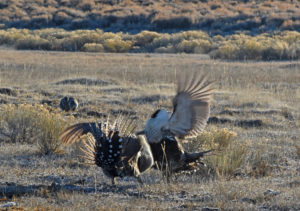February 2, 2023

Photo by Erik Molvar
Western Watersheds Project and our co-plaintiffs, Center for Biological Diversity and WildEarth Guardians, have just notched a major victory for sage grouse in our legal challenge against the recently-approved Caldwell Canyon phosphate mine in southeastern Idaho.
A federal judge’s ruling held that the Bureau of Land Management improperly authorized a mine access road to be built inside the 2-mile lek buffer for an active sage grouse lek (or breeding and dancing site), violating the habitat protections guaranteed in the agency’s own land-use plan. Not only do roads within 2 miles of sage grouse cause significant declines in lek attendance (in many cases causing the lek to be abandoned), but sage grouse are also known to nest within 5.3 miles of lek sites, meaning that the access road was built right through prime nesting habitat. The Bureau tried to argue that the Idaho Department of Fish and Game classified the impacted lek as “pending” rather than “active,” but the judge ruled that because sage grouse breeding was observed at the lek site in 3 of the past 5 years, it met the federal definition of an active lek, regardless of the state’s classification.
The judge also ruled that the agency failed to adequately consider the cumulative impacts of this mine together with the impacts of other open-pit mines and infrastructure in the area on the declining East Idaho Uplands sage grouse population. During its sage grouse planning process, the Bureau of Land Management followed state recommendations and largely withheld Priority Habitat designations in southeast Idaho, which would have provided stronger sage grouse protections (probably to appease the phosphate mining industry). The sage grouse population here has suffered accordingly. Despite this, our win shows that even the lesser level of sage grouse protections on the books in this part of Idaho still carries the full weight of the law.
The Caldwell Canyon court ruling creates a powerful legal precedent showing that state designations, which often would be less protective, don’t take precedence over federal sage grouse protections, and that federal agencies must analyze the likelihood that collective federally-authorized actions will cause sage grouse populations to collapse. This precedent could have far-reaching effects for our efforts (and others) to save sage grouse habitats!
The phosphate mine is owned by the Bayer pharmaceuticals company, through subsidiaries including Monsanto, and it was intended to provide the phosphate for the controversial herbicide Roundup, a chemical poison linked to toxicity in humans as well as fish, amphibians, and pollinators. The phosphate mill in Soda Springs, where the ore would be processed, is already a Superfund site due to previously existing contamination issues, and the judge faulted the Bureau in this case for ignoring the environmental impacts of extending contamination at this plant.
Many thanks to attorneys from the Center for Biological Diversity and Advocates for the West who brought us this significant win!






